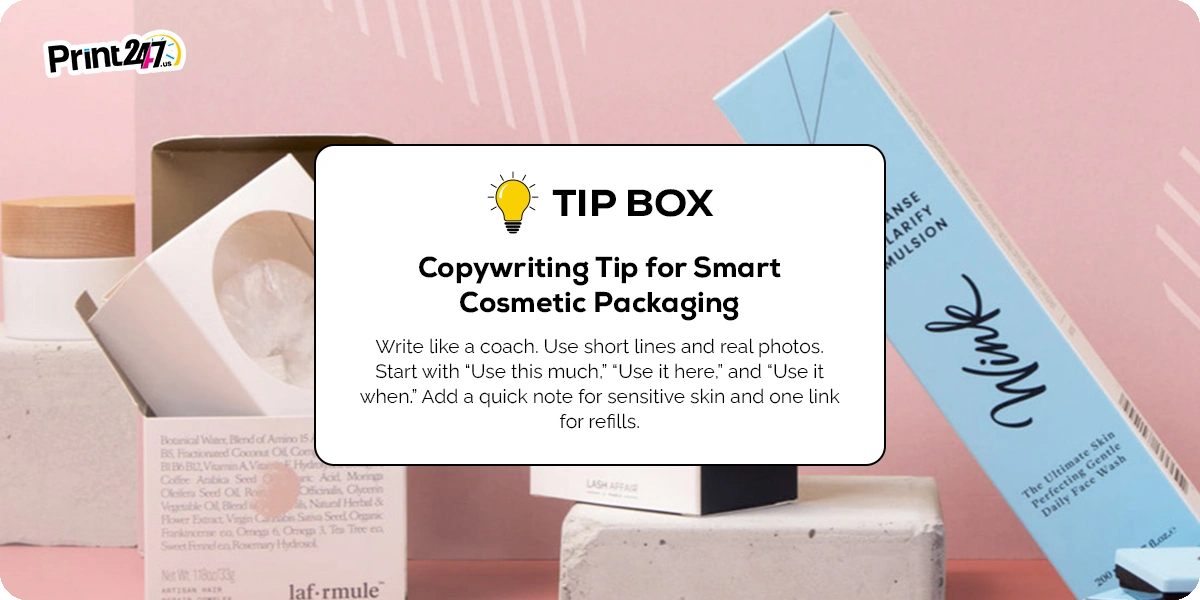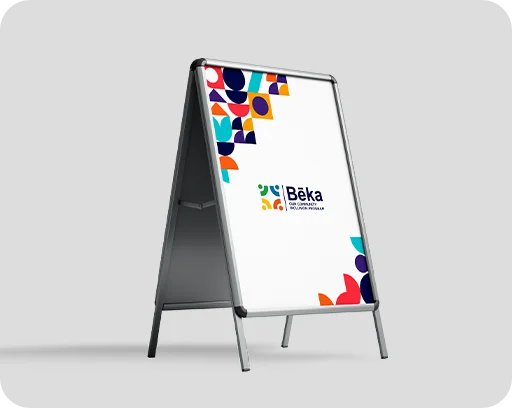How Smart Packaging Technology is Changing Cosmetic Boxes in 2025
.jpg)
Smart packaging uses digital technologies, including NFC tags, QR codes, and augmented reality (AR). Cosmetic brands implement this to increase customer engagement with engaging content and virtual try-ons. These digital innovations guarantee authenticity and ingredient transparency and facilitate digital experiences for beauty products.
If you sell beauty products, you already know the box has a big job. It must look good on the shelf, carry legal text, and arrive in one piece. In 2025, it will also need to help shoppers feel safe and make better choices.
A small code or chip on the carton can now answer questions right away:
Is this real?
What’s inside?
How do I use it?
Can I refill it?
The same code can guide a buyer to the exact shade match or show a short routine. On the brand side, the scan helps lower returns, fix stock errors, and share updates without reprinting.
New rules are pushing more product data to be available by phone, and retail is moving toward smarter barcodes. This guide explains what smart technology means for cosmetic boxes, which tools work best, and how to roll them out in a calm, simple way that fits your artwork and your budget.
You will see where to start, mistakes to avoid, and how to plan for the next two years without stress.
What “Smart Packaging” Really Means for Cosmetic Boxes?
Smart packaging connects the box packaging to live product data. The link is usually a visible QR code or a hidden NFC or RFID tag. You scan or tap with a phone, and a page opens with clear help. For everyday lines, a printed QR is the easiest path.
It is low-cost and works on any modern phone. For prestige lines, NFC feels smooth because the customer only needs one tap. In retail stock rooms, RFID helps count many units in very little time. One digital identity per item is the heart of this system.
With that, you can show guides, verify the item, and help the buyer come back for a refill. A good, smart cosmetic box acts like a friendly assistant who speaks up at the right moment and then gets out of the way.

Why is 2025 a tipping year for smart cosmetic boxes?
This year, two waves are pushing beauty boxes to get smarter. Here's a further explanation of both of them.
First, retail is preparing for 2D barcodes that can carry more data than the old one-line UPC. By the end of 2027, checkout systems are expected to read both 1D and 2D codes, and many pilots are already live. That means a single square on your carton can serve the cashier and the shopper’s phone at the same time, which saves space on the pack and keeps designs clean.
Second, the EU Eco-design for Sustainable Products Regulation (ESPR) is setting up Digital Product Passports (DPPs) for many categories. A DPP is usually reached by scanning a code on the product or box. It holds verified facts like materials or care steps.
Early plans and work programs are out, so brands that sell into the EU are mapping data and running pilots now. One practical number to remember here is 2026 as an early start for some sectors, with rollouts phasing in after that point.
What this means day to day: smart codes move from “nice to have” to “part of labeling.” If you start now, you will have time to test content, train your team, and keep your cartons tidy.
The Core Blocks Of Smart Technology in Cosmetic Packaging: QR, NFC, and RFID
The beauty industry is a highly competitive and profitable sector in the modern era. It drives companies to harness technology to revolutionize packaging design and foster deeper connections with customers. It is a trend that is gaining momentum at an unprecedented rate for cosmetic box packaging.
#1 - QR codes with GS1 Digital Link
A QR is a small, square pattern printed on the carton. When scanned, it opens a web page that can change over time. If you encode it using GS1 Digital Link, the same symbol can carry your global trade number and still feel like a normal website link.
This helps one code serve many jobs: product page, ingredients, shade info, or even a return policy. One simple fact worth noting is that a QR with a proper quiet zone can be scanned at arm’s length by most phones, which is perfect for unboxing.
QR code design guidance for cosmetic packaging
- Keep the square large enough to be seen.
- Avoid heavy gloss or foil over the code area, and print-test on the real board you use.
- On dark cartons, add a white patch behind the code so phone cameras can read it fast.
#2 - NFC for a premium, “just tap” moment
NFC is a thin chip placed under a label or inside a folding carton panel. The cosmetic buyer taps the pack with the top of the phone, and a page opens. It feels smooth and private, which is why prestige lines like it for auth checks and VIP content.
One number to remember is one tap: there is no camera step, and that cuts friction during cosmetic packaging unboxing. NFC tags can also help run limited perks for members, since you can tell a fresh scan from a screenshot.
Market studies show steady growth for NFC in packaging through the decade, as phones support it by default. The NFC embedded packaging market size will reach USD 14,573 million in 2032. (Source: Credence Research Inc.)
#3 - RFID for fast counts and cleaner omnichannel
RFID tags are made for the warehouse and the back room. A reader can pick up many items at once, which makes cycle counts fast and reduces “phantom stock.” That matters when your most popular shades keep going out of stock.
A public case in fragrance reported sharper inventory accuracy after pairing RFID tags with a product cloud, which sped up restock decisions for stores. One easy figure to keep in mind: a single read can capture dozens of items in a second when items are placed well. That’s the main benefit of RFID tags for the beauty products business.

How does smart packaging support clean retail operations in the beauty business?
Retailers want fewer gaps on shelves and better online order pick times. Smart packaging improves clean retail operations in the beauty business. It renews the traditional cosmetic packaging box into a digital tool for a safer, more efficient, and more transparent retail environment.
Here’s how:
RFID helps here because staff can count rows in seconds instead of minutes. For brands, this cut returns due to wrong picks and keeps top shades topped up. Some beauty teams also use scan data to spot unusual spikes in one city, which can point to fake goods or unusual markdowns.
If you sell directly, a QR on the box can also send back “reason for return” with one tap, which helps find issues early. A case in fragrance showed that linking RFID tags to a product cloud gave both the brand and stores a live view of stock. It helped move items before a launch pushed new units out.

(Source: GM Insights)
Costs, savings, and the simple ROI story
A printed QR adds little to unit cost. Most spending is in writing and hosting good content. NFC adds a small unit cost that makes sense for prestige items where trust and service matter more. RFID is a program cost that saves labor and cuts stock errors at scale.
A fair way to set the ROI target is to pick one lever per line: fewer returns, better restocks, or more refills. Measure that lever first. One clean number is easier to defend in a meeting than a stack of charts, and it helps you decide the next move.
Final Words
Smart packaging is not about chasing shiny tech. It is about making the cosmetic box do one extra job for the person who just bought your product. A good code or tag answers a question in the few seconds after unboxing, when trust is won or lost.
One clear page can explain how to apply, how much to use, and how to care for the product, without forcing the shopper to search your site. On your side, the same scan can confirm the item is real, cut returns, and guide people to refills.
Retail is moving toward 2D codes by 2027, and rules push more product data to be available by scan, so the timing is good to start. Begin with one SKU, a tidy QR, and a mobile page that does not waste time. Watch what people do, fix what they skip, and add features only when they prove useful.
Keep privacy tight, keep artwork clean, and work closely with your printer so the code reads well on your real board. Done this way, a smart box feels simple, kind, and helpful, the way beauty should feel.
Get in touch with Print247, a leading packaging manufacturing brand, if you're running a beauty or cosmetic brand and want smart packaging technology. As a leading provider of digital cosmetic packaging solutions, we offer smart and digital solutions to meet the demands of modern customers.
FAQs
Do I need both QR and NFC on the same cosmetic carton?
Not always. For most lines, a single QR is a strong start and covers the widest range of shoppers. Add NFC where a smooth tap and fast auth matter most, like limited drops or high-price skincare.
Will a code ruin my design?
No. A small, high-contrast square on a side or back panel looks neat if you keep a quiet zone around it. Test at 12 mm or more on your board to stay safe across phones.
How do I handle several countries with one box?
Use a GS1 Digital Link and routing rules. The same code can guide a buyer to the local language and required text based on the scan source. Keep one canonical product page that you localize.
Can this help with fake cosmetic products?
Yes. You can give each unit a unique digital ID and check it on scan. If valid, show a green check and batch. Keep it short and calm. Reports show double-digit growth for anti-fake features in pharma and beauty.
What will retailers expect by 2027?
They plan to read both 1D and 2D at checkout. A single 2D code can serve the till and the phone. Plan now so your 2026 art files already have space. 2027 is the key milestone.


















































.jpg)
.jpg)
.jpg)